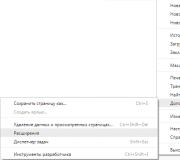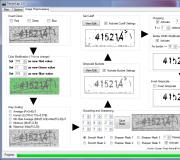What is hash sum. What is a checksum (hash) and how to check it
Instructions
Find in Total commander the file whose checksum you want to check. Start Total Commander. In one of the panels, change the current disk to the one you are looking for. To do this, you can use the buttons or the drop-down list located on the top toolbar. Making double clicks according to the items in the directory listing list, go to the directory with the required file. Highlight it in the list.
Open the dialog for configuring the parameters for calculating checksums of files. To do this, in the main application menu, expand the "File" section, and then click on the "Create SFV file of checksums (CRC) ...".
Configure the parameters for generating checksums. In the "Create SFV checksum files (CRC)" dialog box, select the "MD5" checkbox if you want the result of the file checksum calculation to be an MD5 hash (most of the checksums published on the Internet are MD5 hashes). Uncheck the "Create a separate SFV file for each file" checkbox. In the "Save file (s) checksums as:" field, enter the path and name of the file where the result of the checksum calculation will be placed.
Calculate the checksum of the file. In the "Create SFV Checksum (CRC) Files" dialog box, click the "OK" button. The process of calculating the checksum will begin. The progress of the process will be displayed by a progress indicator in the window that appears. If the volume source file is large, the checksum may take long time... Wait for the end of the operation.
Check the checksum of the file. Open the generated checksum file in text editor or viewer. In particular, you can use the view function built into Total Commander. To do this, highlight the generated checksum file in Total panels Commander and press the F3 key. The file will contain a line that is structured in two parts. The first part of it, located before the "*" sign, is the symbolic representation of the file's checksum. Compare this line with known value checksum.
Verification of the checksum is necessary in order to check the integrity and completeness of the data transfer when downloading documents via communication channels. This is especially important when loading a Windows operating system distribution kit. This will allow you to avoid errors in the system and protect yourself from pirate copies and viruses.
Instructions
Go to the official website of the document, software or the operating system that you downloaded to your computer. In the file details section, you can find the checksum value, which is also referred to as SHA1. Save this set characters into a separate text file or copy it onto a piece of paper.
Download the HashTab utility. This program is distributed on many specialized computer sites, so it is quite easy to find it on the net. However, it is best to use the official source http://hashtab.ru/ to protect your computer from various viruses... Just in case, check the downloaded file with an antivirus. The software is made in two versions, one for Windows, and the other for Mac.
Install the program on your computer. Navigate to the file being scanned and click on it right click mice. If you have an operating Windows system, then go to the "Properties" section and select the "File Hash Sums" tab. If you are using Mac OS, select the File Hashes section and click on More. If these tabs are missing, then you have incorrectly installed HashTab.
In some situations, it may be necessary to calculate the MD5 hash for a file that you downloaded to your computer. For example, to make sure that you downloaded exactly the file you wanted and that the attacker did not modify it. In this article, we will look at 2 different ways to do it: via the explorer extension, as well as via command line.
For Windows explorer there is a great program called Hashtab which is free for non-commercial use. You can download it from. Select the free (Free) version and click on the "Download" button.
After installing the program, in context menu explorer will appear new inset"File hash sums", by selecting which, the program will automatically calculate hash sums for the selected file, depending on which algorithms are selected in its settings. 
Option through the command line (with the installation of the program)
In case it is necessary to calculate the hash-sum of a file via the command line, we can use a utility from Microsoft, which is suitable just for such cases. Download it from and install it. To do this, you will need to create a folder on your hard drive and specify it during the installation process. In our example, the program was installed in the C: \ Program Files (x86) \ FCIV folder. In order to calculate the MD5 hash of a file, we need to start the command line and type the following command in it:
"C: \ Program Files (x86) \ FCIV \ fciv.exe" -md5 C: \ Users \ Admin \ Downloads \ HashTab_v6.0.0.34_Setup.exe

As you can see, the MD5 hash sum is the same for both the first option and the second.
"C: \ Program Files (x86) \ FCIV \ fciv.exe" is the path to fciv.exe
-md5 - specifying the algorithm by which fciv.exe will calculate the hash sum
C: \ Users \ Admin \ Downloads \ HashTab_v6.0.0.34_Setup.exe is the path to the file for which we calculate the hash sum.
Option through the command line (without installing programs)
In the event that you do not want to install any programs, then you can get by with the built-in Windows tools, you can use the CertUtil utility for this.
To check the MD5 hash, just enter the following command:
Certutil -hashfile C: \ Users \ Admin \ Downloads \ HashTab_v6.0.0.34_Setup.exe MD5
C: \ Users \ Admin \ Downloads \ HashTab_v6.0.0.34_Setup.exe- this is the path to the file, the hash-sum of which we want to calculate.

As you can see in the screenshot, the hash of our file 62130c3964... is completely identical to the one we got using the first and second methods.
Rate article
Other articles:
- An error occurred during authentication. The specified function is not supported. ...
Have you ever wondered why such information as "Hash-sum" is indicated? Very often found on torrents. On the one hand, some incomprehensible information, but on the other hand, very useful. Why? I will try to tell you in detail how to find out the hash of a file, how to compare it, and why it is so useful.
Let's figure out how to find out the hash of a file and in what cases this hash will be extremely useful for us. I will not go deep into the topic, I will tell you with an example. simple language that would be clear to everyone!
Why do I need to know the hash-sum of a file?
Let's say you decide to download an image of a game from a torrent and have fun. You have found interesting game, read the description and found that the description for the file contains the "Hash-Sum" of the image.
The fact is that the person who posted the game first checked it for performance on his computer, maybe even on several PCs and on different systems.
As soon as he was convinced that everything was installed and working perfectly, he recognized the "Hash-Sum" of the image and indicated it in the description for the game. Unknowing people ask themselves the question, why did he indicate the hash-sum of the image?
Roughly speaking, the hash-sum is a unique "Key" of a file that can be used to check the file, that is, its integrity.
To put it even simpler: That, the hash will allow us to compare two files, the file that was uploaded to download, with the file that was downloaded to our computer.
And why should I compare it? Let's say you downloaded the image and naturally set about installing the game. But during the installation process, some errors began to appear, something goes wrong. All signs that the game will not install, as it is needed, or installed, but does not start.
In general, there are similar problems ...
Of course, you can blame the place where the file was downloaded for all the troubles. They say that the file is not of high quality, there is nothing that does not start, nothing that does not work.
But that may not be the case.
Everything is in order with the system, and with the source from which the file was downloaded, everything is in order.
Everything is actually much simpler than it seems. In the process of downloading the file, some errors could occur, or the file was not downloaded to the end, in general, in one word, the file was not fully downloaded to the computer for some reason.
Here, all the troubles come from here!
We go to the site where the file was downloaded from, take the hash-sum there, after which we find out the hash of the downloaded file and compare them.
1) If the Hash-Sum is different, then the uploaded file is 100% different from the one posted on the site. This means that the downloaded file will not work. You will have to download it again.
2) If the Hash-Sums are the same, then in this case the exact copy file and it will work as expected. You can safely proceed with the installation.
IMPORTANT! If you swing Windows images then, after downloading, I strongly recommend that you find out the hash-sum and compare it, if the sums do not match, then better times 100 to think about whether to install windows with a similar image.
Otherwise, you can get a lot of problems during the installation of the system.
In general, I think everything is clear, if you have any questions, then feel free to ask! Okay, we figured out why we need the hash-sum of the file that we are going to download. Now let's find out how to compare the hash-sum to find out if the file has completely downloaded or not.
How to find out and compare the Hash-Sum of a file.
For this case there is special programs and they are generally easy to use. All you have to do is choose desired file to get its hash amount and compare it with the one indicated on the site. It's that simple!
I want to present one of these programs in this post. Program, so to speak, "Own production" I was sitting at my laptop yesterday, and I understand that I kind of missed "Coding" and decided that there will be more hash-sums for one program.
The program interface looks like this. Buttons turned out without labels, but for each button there are hints for what it is needed. They appear at the bottom of the program when you hover over the button.
1 - This button will open a dialog box for selecting files.
2 - This button is needed if you want to delete the contents of the fields.
.
4 - This button will close the program.
5 - This button is needed if you need to copy the Hash-Sum to the clipboard.
6 - This button is the other way around, insert the Hash-Sum, for comparison.
To compare hash sums, press the "1" button and select the file that was downloaded. The program will determine its hash-sum in md5 encoding, and it will appear in the "Received Hash" field.
Now in the field "Compare with:" paste the hash-sum specified in the description of the downloaded file. Click the "Compare" button and the program will show the result and the following window will appear:
- Hash-Sums are equal:
- Hash-Sums are not equal:
And one more important point about my program. If you use it, then when you receive a hash-sum of a file with large size, the program will freeze for a short time, the system will offer to terminate the program ...
In fact, the program is working and soon it will show the hash sum of the file. And the program hangs up, because you need to modify it a little, namely add an "additional thread". In general, do not pay attention to the fact that the program "Not responding" these are my errors, it all works exactly!
How does the hash-sum of a file change? (For understanding)
I suggest looking at real example how the Hash-Sum of the file can change. Let's take a regular text document as an example.
Let's create a file "test.txt" and write any line into it, for example, from three characters "123". Now let's save the file and see its size, it will be only "3 bytes".
Since one character weighs only 1 byte and it doesn't matter what it is, a character or a space.
However, this is not very important. What matters is that we are in in this case we have the ability to remove 1 byte from the file, or vice versa, add several bytes to the file. Text document(TXT) is perfect for this example.
And so, save the file with the string "123" and look at its Hash-Sum. I got it like that.
Default
MD5: 202CB962AC59075B964B07152D234B70
MD5: 202CB962AC59075B964B07152D234B70 |
Good! We save the received "Hash-Sum" Somewhere else. Now we open the file "test.txt" again and add one more character to the line, and as a result we will get such a string "1234". We save this file and recognize its "Hash-Sum" again. Here's what happened.
Often, getting the treasured hashes is not all that needs to be done before starting a brute. Sometimes it is also useful to understand what, in fact, we will brute, determine the hash, or in other words, find out what kind of hash was caught during the penetration test.
The most in a simple way find out hash algorithm - online service. One of the most popular online hash determination services is a website.
Use this service very simple:
- Go to onlinehashcrack.com
- Enter the found hash
- You get the result
The service can detect over 250 types of hashes.
Determining a hash using hashID
In some cases, it will be difficult to surf the Internet to determine the type of hash. In such situations, you can use special utilities... One of the most popular today is the hashID tool.
This utility has replaced the HashTag and Hash-Identifier utilities.
hashID is an extremely useful Python 3 tool that will try to figure out what kind of hash is in front of it.
The hashID library has over two hundred different hash signatures and the services that use them.
 Determining the hash using the hashID utility
Determining the hash using the hashID utility The utility is friendly with, and also runs without problems on the second Python branch.
Setting hashID
$ pip install hashid
$ pip install --upgrade hashid
$ pip uninstall hashid
Download hashID
The utility is available from GitHub. You will also find there full list supported hashes in the Excel file.
That's all. These hash detection tools should be enough for you. To all Have a good mood and information security!
Each file has its own unique value that can be used to validate the file. This value is called a hash or checksum. It is often used by software developers when referring to files. The file is checked against the checksum in order to identify its integrity and match with the specified identifier.
There are several algorithms for calculating the checksum of a file, among which the most famous and widespread are MD5, SHA256, SHA1, SHA384. You can calculate the hash of a file, that is, its checksum, as standard tools Windows and third party services... In this article, we'll look at how to do this.
Table of contents:How to find out the hash of a file via the command line
Command Prompt in Windows allows you to run various actions, both with the system itself and with individual files. Through it, you can determine the checksum of files using the built-in utility CertUtil.
To find out the hash of the file through the command line, it is enough to enter the following query into the command line:
Certutil -hashfile * file path * * algorithm *
Instead of * path to file * you need to enter full path to the file. For example: d: \ 8.jpg
Instead of * algorithm *, you need to enter the name of the algorithm by which you want to calculate the checksum. The CertUtil utility can calculate the checksum according to the algorithms: MD2, MD4, MD5, SHA1, SHA256, SHA384, SHA512.
After executing the specified command, you will be able to see the file hash calculated using the CertUtil utility.

How to find out the hash of a file using the PowerShell utility
Another built in Windows utility which is able to determine the checksum of a file is PowerShell. It differs from CertUtil in support more checksum algorithms: SHA256, MD5, SHA384, SHA1, SHA512, MACTripleDES, RIPEMD160.
The following command is used to check the hash through the PowerShell utility:
Get-FileHash * file path * | Format-List
Instead of * path to file *, you must specify the full path to the file whose checksum is being checked.
It is important to note that PowerShell calculates the checksum using the SHA256 algorithm by default.

If you need to use a different algorithm, you must specify this in the command when executing the query. For example, to determine the hash using the MD5 algorithm, you will need to run the command:
Get-FileHash * file path * -Algorithm MD5 | Format-List

Instead of MD5, you can specify other algorithms supported by the utility.
How to find out the hash of a file using the HashTab utility
In addition to Windows tools to determine the checksum of the file you can use third party applications... For example, one of convenient programs able to determine the hash of a file is a HashTab. This is an extremely simple application that can be downloaded from the Internet for free.
After loading HashTab programs and installation, a new tab is created in the file properties, which is called "File hash sums". In this tab, you can see the calculation of the checksum for the file in various algorithms.




